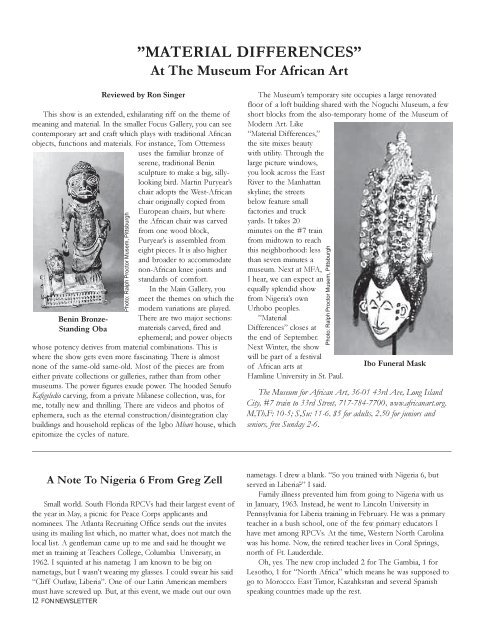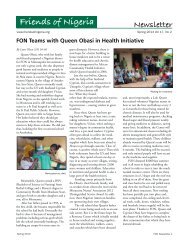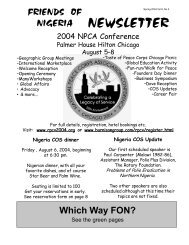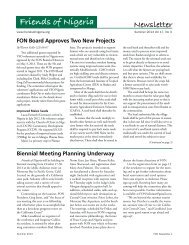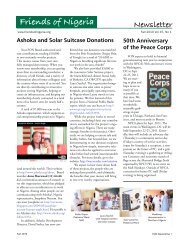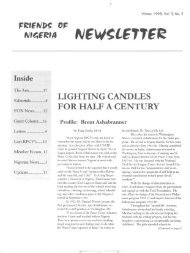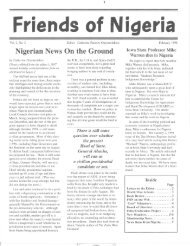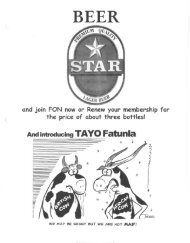0704 Summer 2003.pdf - Friends of Nigeria
0704 Summer 2003.pdf - Friends of Nigeria
0704 Summer 2003.pdf - Friends of Nigeria
Create successful ePaper yourself
Turn your PDF publications into a flip-book with our unique Google optimized e-Paper software.
”MATERIAL DIFFERENCES”At The Museum For African ArtReviewed by Ron SingerThis show is an extended, exhilarating riff on the theme <strong>of</strong>meaning and material. In the smaller Focus Gallery, you can seecontemporary art and craft which plays with traditional Africanobjects, functions and materials. For instance, Tom Otternessuses the familiar bronze <strong>of</strong>serene, traditional Beninsculpture to make a big, sillylookingbird. Martin Puryear’schair adopts the West-Africanchair originally copied fromEuropean chairs, but wherethe African chair was carvedfrom one wood block,Puryear’s is assembled fromeight pieces. It is also higherand broader to accommodatenon-African knee joints andstandards <strong>of</strong> comfort.In the Main Gallery, youBenin Bronze-Standing ObaPhoto: Ralph Proctor Musem, Pittsburghmeet the themes on which themodern variations are played.There are two major sections:materials carved, fired andephemeral; and power objectswhose potency derives from material combinations. This iswhere the show gets even more fascinating. There is almostnone <strong>of</strong> the same-old same-old. Most <strong>of</strong> the pieces are fromeither private collections or galleries, rather than from othermuseums. The power figures exude power. The hooded SenufoKafigeledio carving, from a private Milanese collection, was, forme, totally new and thrilling. There are videos and photos <strong>of</strong>ephemera, such as the eternal construction/disintegration claybuildings and household replicas <strong>of</strong> the Igbo Mbari house, whichepitomize the cycles <strong>of</strong> nature.The Museum’s temporary site occupies a large renovatedfloor <strong>of</strong> a l<strong>of</strong>t building shared with the Noguchi Museum, a fewshort blocks from the also-temporary home <strong>of</strong> the Museum <strong>of</strong>Modern Art. Like“Material Differences,”the site mixes beautywith utility. Through thelarge picture windows,you look across the EastRiver to the Manhattanskyline; the streetsbelow feature smallfactories and truckyards. It takes 20minutes on the #7 trainfrom midtown to reachthis neighborhood: lessthan seven minutes amuseum. Next at MFA,I hear, we can expect anequally splendid showfrom <strong>Nigeria</strong>’s ownUrhobo peoples.”MaterialDifferences” closes atthe end <strong>of</strong> September.Next Winter, the showwill be part <strong>of</strong> a festival<strong>of</strong> African arts atIbo Funeral MaskHamline University in St. Paul.Photo: Ralph Proctor Musem, PittsburghThe Museum for African Art, 36-01 43rd Ave, Long IslandCity, #7 train to 33rd Street, 717-784-7700, www.africanart.org.M,Th,F: 10-5; S,Su: 11-6. $5 for adults, 2.50 for juniors andseniors, free Sunday 2-6.A Note To <strong>Nigeria</strong> 6 From Greg ZellSmall world. South Florida RPCVs had their largest event <strong>of</strong>the year in May, a picnic for Peace Corps applicants andnominees. The Atlanta Recruiting Office sends out the invitesusing its mailing list which, no matter what, does not match thelocal list. A gentleman came up to me and said he thought wemet in training at Teachers College, Columbia University, in1962. I squinted at his nametag. I am known to be big onnametags, but I wasn’t wearing my glasses. I could swear his said“Cliff Outlaw, Liberia”. One <strong>of</strong> our Latin American membersmust have screwed up. But, at this event, we made out our own12 14 FON NEWSLETTERnametags. I drew a blank. “So you trained with <strong>Nigeria</strong> 6, butserved in Liberia?” I said.Family illness prevented him from going to <strong>Nigeria</strong> with usin January, 1963. Instead, he went to Lincoln University inPennsylvania for Liberia training in February. He was a primaryteacher in a bush school, one <strong>of</strong> the few primary educators Ihave met among RPCVs. At the time, Western North Carolinawas his home. Now, the retired teacher lives in Coral Springs,north <strong>of</strong> Ft. Lauderdale.Oh, yes. The new crop included 2 for The Gambia, 1 forLesotho, 1 for “North Africa” which means he was supposed togo to Morocco. East Timor, Kazahkstan and several Spanishspeaking countries made up the rest.


